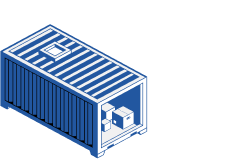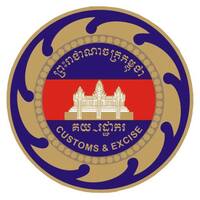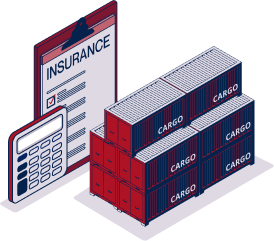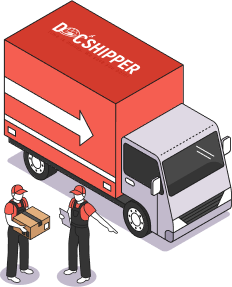Freight Shipping between Thailand and Cambodia | Rates – Transit times – Duties and Taxes
Ever tried swapping Pad Thai for Amok Trey via camel convoy? Neither have we! The real challenge lies in the intricacies - understanding rates, unpicking transit times, and deciphering customs regulations when shipping freight between Thailand and Cambodia. This guide will explore these complexities, from choosing the best freight option for your business - be it air, sea, road, or rail - to mastering the maze of customs clearance, duties, and taxes. You'll gain expert insights specifically tailored to the nuances of these two Southeast Asian nations, empowering your decision-making and transforming potential roadblocks into stepping stones. If the process still feels overwhelming, let DocShipper handle it for you! As your international freight forwarding partner, we turn shipping obstacles into successes, guiding your business every step of the way.
Which are the different modes of transportation between Thailand and Cambodia?
Shipping goods from Thailand to Cambodia is a real-life puzzle, much like hopping from one city to another in a road trip. With just 800 km between Bangkok and Phnom Penh, road and rail transportation stand as the quickest, most practical solutions. It's like choosing a car over an airplane for a cross-country adventure. The right choice considers practicality and aligns with your shipment's unique demands. Let's buckle up and delve deep into the options for making this journey the best it can be. Fasten your seat belts, shipping enthusiasts - we're headed for an insightful ride!
Need help with your shipment?
Need assistance with your shipment? Dont hesitate to contact us even for a simple question. Choose the option that suits you
Live chat with an expert Chat on WhatsApp Free Quote 24hHow can Siam Shipping help you

Sea freight between Thailand and Cambodia
Ocean shipping between Thailand and Cambodia – two nations with a dynamic and evolving trade relationship. Key cargo ports like Laem Chabang in Thailand and Sihanoukville in Cambodia serve as crucial connection points, busily moving goods across the Gulf of Thailand. For businesses shipping high-volume goods, sea freight proves a cost-effective method despite its longer transit times.
Now, we’ll acknowledge that this route isn’t without its pains. The challenges of imperfect documentation, customs clearance errors, and transport issues can frazzle even the seasoned shippers. It’s like hosting a grand international dinner party: shopping for the right ingredients, timing your courses and meeting dietary regulations can be a daunting task if you’re unprepared or ill-informed!
But, worry not. By following a few specifications and best practices, which we’ll dive into here, you can ensure your goods traverse these waters as smoothly as a floating lantern on a clam sea, avoiding common hindrances and helping improve your shipping efficiency.
Main shipping ports in Thailand
Port of Laem Chabang
Location and Volume: Positioned on the Gulf of Thailand, Laem Chabang caters to most of Thailand’s maritime cargo traffic, handling approximately 18 million TEUs in 2022.
Key Trading Partners and Strategic Importance: The port is a fundamental link in the trade networks with China, USA, Vietnam, and Singapore. It’s gained prominence for having the country’s first deep-sea terminal.
Context for Businesses: If you’re seeking to tap into the Asia-Pacific market, particularly the robust economies of China, or the burgeoning markets of Vietnam, Laem Chabang, with its sophisticated facilities and strategic location, would be advantageous to your shipping strategy.
Port of Bangkok
Location and Volume: Located on the Chao Phraya River, the Port of Bangkok is the national port and handles around 8,7 million TEUs.
Key Trading Partners and Strategic Importance: China, US, Japan, and Malaysia are among its key trading partners. It also serves as a significant riverine port, connecting to the interior regions of Thailand.
Context for Businesses: If you’re focused on reaching Thailand’s local markets or industries concentrated along the Chao Phraya River, the Port of Bangkok could align with your logistical needs due to its domestic reach and connectivity.
Port of Map Ta Phut
Location and Volume: Situated in Eastern Thailand, Map Ta Phut port is the world’s 8th largest port in terms of cargo volume, handling approximately 16 million metric tons.
Key Trading Partners and Strategic Importance: Map Ta Phut is particularly crucial for industrial businesses and it primarily exports oil and chemical products to countries like China, Japan, and South Korea.
Context for Businesses: If your business deals in oil, gas, or other industrial goods, Map Ta Phut’s specialised port facilities and heavy export volumes may render it a key part of your shipping processes.
Port of Sattahip
Location and Volume: Located in the eastern part of the Gulf of Thailand, Sattahip is a Thai naval base which also functions as a commercial port, handling about 1,1 million TEUs annually.
Key Trading Partners and Strategic Importance: Sattahip’s main trading partners are Indonesia, China, and Cambodia. It is also a critical port for global humanitarian missions due to its strategic location and navy-operated facilities.
Context for Businesses: If your business focusses specifically on bulk cargo and has strong links with Southeast Asia or the humanitarian sector, Sattahip’s well-equipped facilities and unique humanitarian importance should be of keen interest to you.
Port of Songkhla
Location and Volume: Located in Southern Thailand, the Port of Songkhla handled around 3 million tons of cargo.
Key Trading Partners and Strategic Importance: It is a key link with Malaysia, Singapore, and Indonesia. The port is particularly important due to its proximity to the South China Sea and the potential trade routes this opens up.
Context for Businesses: If you’re dealing in bulk and breakbulk cargo and are interested in penetrating markets in Southeast Asia, particularly the economically vital straits region, selecting Songkhla as part of your shipping route would likely be a smart move.
Port of Si Racha
Location and Volume: Located just north of Laem Chabang in the Chonburi Province, Si Racha is predominantly a tanker port with an annual volume of approximately 4,5 million tons.
Key Trading Partners and Strategic Importance: Australia, India, the US, and China all trade with Si Racha. The majority of traffic is petroleum, crude oil, and liquefied gas coming from or heading to these countries.
Context for Businesses: If you’re involved in the energy sector with targeted markets in the US, China, India, or Australia, Si Racha, with its focus on petroleum traffic, could serve as a pivotal asset in your logistics strategy.
Main shipping ports in Cambodia
Sihanoukville Autonomoous Port PAS
Location and Volume: Located on the Gulf of Thailand, the Sihanoukville Autonomous Port PAS is Cambodia’s main maritime shipping point and the largest national port. With a shipping volume that exceeded 1,15 million TEUs in 2023, it serves as a key commercial link for imports and exports to the country.
Key Trading Partners and Strategic Importance: PAS is strategically positioned as a key gateway to major markets such as China, Vietnam, Asia’s hinterland countries, and international routes through the Malacca Strait to Europe, Africa, and the Middle East. The port is a Free Trade Area and an Economic Special Zone with advanced equipment for efficient cargo handling.
Context for Businesses: If you’re looking to establish a robust gateway into Southeast Asia, the Sihanoukville Autonomous Port’s significant trading volume, connectivity, and customs facilities make it an advantageous choice for expanding your shipping strategy.
Phnom Penh Autonomous Port PPAP
Location and Volume: Situated on the upper Mekong River, PPAP is the second main port of Cambodia. It’s a crucial inland port that handles an annual volume of around 394,678 TEUs in 2022, which includes heavy cargo like construction materials and bulk agricultural products.
Key Trading Partners and Strategic Importance: Major trading partners include China and Singapore. Furthermore, Phnom Penh Autonomous Port is essential for transporting goods between Cambodia’s rural heartland and Ho Chi Minh city in Vietnam, providing a vital import-export pipeline for businesses in these regions.
Context for Businesses: For businesses primarily dealing with agricultural products or heavy-duty materials, PPAP provides an indispensable route to the thriving markets in Vietnam and the rural areas of Cambodia. By tapping into this inland port, businesses can streamline their logistics and potentially reduce transit times and costs.
Cambodia, primarily maintains these two international ports, each one offering unique advantages based on geographic location, trading partners, and specialization. Both have distinct roles in the national and international supply chain, and carefully considering their features in your logistics strategy may offer significant benefits to your business.
Should I choose FCL or LCL when shipping between Thailand and Cambodia?
Choosing between Consolidation (LCL) and Full Container Load (FCL) when shipping goods between Thailand and Cambodia is like selecting your own path in the vast sea of logistics. Each choice has distinct benefits that could spell the difference in cost, delivery times, and overall shipment success. In this section, we’ll guide you in understanding these options, aiding you to make an informed decision suitably tailored to your shipping needs. Let’s deep dive into the world of FCL and LCL, and carve your success story in the international trade market!

Full container load (FCL)
Definition: FCL, or Full Container Load, is a type of shipping mode where an entire container is dedicated to a single consignee. Much like a private ride, no other consignee's goods share this space.
When to Use: FCL shipping is a cost-effective choice when dealing with a high-volume shipment, typically more than 13/14/15 CBM. It offers an increased level of safety because the container is sealed at the origin and remains untouched until it reaches its destination.
Example: Imagine a Bangkok-based furniture company exporting 30 CBM of tables and chairs to Phnom Penh. With such volume, an FCL shipping quote would be cheaper. The company could opt for a 20'ft container or a 40'ft container, depending on their need, knowing their goods won't be mixed with others, further maintaining the quality.
Cost Implications: While the initial fcl shipping quote may seem high, it becomes cost-effective when shipping larger volumes. FCL container charges are fixed regardless of how full the container is. So, for a 20'ft or 40'ft container, the cost per CBM becomes cheaper the more you ship. This high-volume, lower cost dynamic makes FCL shipping advantageous for sizeable shipments.

Less container load (LCL)
Definition: Less than Container Load (LCL) shipping, also known as consolidation, is a type of ocean freight where several shippers share space in a single container. When to Use: This option shines when your cargo volume is less than 15 CBM - roughly equivalent to the goods you could store in a small garage. It's a cost-effective and flexible choice for smaller shipments because you only pay for the space your cargo uses. Example: For instance, imagine you're a Thai furniture maker shipping 10 CBM of chairs to a store in Cambodia. Instead of renting a whole container, you share the container space and cost with other businesses, meaning the LCL freight is cheaper and more efficient. Cost Implications: With LCL shipment, freight cost is typically lower as it's calculated based on the volume your goods take up. However, keep in mind that there may be additional charges such as warehousing fees or handling charges at both the origin and destination. Factor these into your considerations when choosing between LCL and Full Container Load.
Hassle-free shipping
Choosing between consolidation or a full container for shipping from Thailand to Cambodia is a complex decision. Let DocShipper, your trusted freight forwarder, simplify it! Our team of ocean freight experts will consider factors like your cargo’s nature, volume, and your business timeline to recommend the perfect solution. Say goodbye to shipping hassles now! Interested in finding the perfect shipping balance? Request a free estimate today and let us streamline your shipping needs!
How long does sea freight take between Thailand and Cambodia?
On average, sea freight between Thailand and Cambodia takes around 15 days. Bear in mind that actual transit times are greatly influenced by factors like the specific ports used, the weight of the cargo, and the nature of the goods being transported. So, for the most accurate estimate suitable for your unique shipping requirements, it’s always best to consult with a freight forwarder like DocShipper for a tailored quote.
Here’s a peek at the average transit times via sea freight between key ports in both countries:
From (Thailand) To (Cambodia) Average Transit Time (Days) Port of Bangkok Port of Sihanoukville 14 Bangkok Container Terminal Port of Phnom Penh 14 Laem Chabang Port Port of Sihanoukville 14 Songkhla Port Port of Phnom Penh 19*Please remember that these times are averages and actual times can vary based on factors discussed earlier.
How much does it cost to ship a container between Thailand and Cambodia?
Determining an exact shipping cost from Thailand to Cambodia can feel as unpredictable as the open sea. However, by understanding ocean freight rates, the fog begins to clear. Your cost could range massively per CBM, influenced by factors like your Point of Loading and Destination, choice of carrier, nature of your goods, and even monthly market tweaks. Without doubt, pitching a specific figure might seem like aiming in the dark. That’s where our seasoned shipping specialists come aboard, tailoring best-rate quotes for each unique shipment. Rest assured, we’ve got you covered, every nautical mile of the journey.
Special transportation services
Out of Gauge (OOG) Container
Definition: An OOG container is a special shipping container that can handle Out of gauge cargo which exceeds the standard dimensions of regular containers. Suitable for: It’s ideal for transporting large items that can’t be broken down into smaller components, such as machinery or vehicles. Examples: Industrial equipment, large vehicles, construction materials. Why it might be the best choice for you: If your goods are large and do not fit in standard containers, OOG is your go-to. Custom solutions are offered to ensure your cargo arrives safely at its destination.
Break Bulk
Definition: This term refers to cargo that must be loaded individually, and not in intermodal containers nor in bulk as with oil or grain. Suitable for: Items that are oversized, heavy, or both, and which might not fit in standard containers. Examples: Construction materials, large machinery, or equipment. Why it might be the best choice for you: This could be the answer to your shipping needs if your cargo is too large or irregularly shaped to fit into a standard container.
Dry Bulk
Definition: Dry Bulk refers to goods shipped in large quantities, stored without a container, and handled as a loose cargo load. Suitable for: Commodities that are shipped in the form of a solid mass, typically homogeneous goods. Examples: Sand, cement, grains, gravel, and other similar materials. Why it might be the best choice for you: If you’re moving large amounts of raw materials from Thailand to Cambodia, dry bulk shipping can be a cost-effective and efficient option.
Roll-on/Roll-off (Ro-Ro)
Definition: Ro-Ro vessels are ships designed to carry wheeled cargo, such as cars, trucks, trailers, and machinery that are driven on and off the ship on their own wheels or using a platform vehicle. Suitable for: Any wheeled cargo such as automobiles, trailers, trucks or heavy machinery and equipment. Examples: Cars, trucks, tractors, trailers or even railway wagons. Why it might be the best choice for you: If your business deals with vehicles, Ro-Ro will offer you the convenience of directly driving or towing your wheeled cargo onto the ship.
Reefer Containers
Definition: Reefer containers are refrigerated containers for shipping goods requiring temperature-controlled conditions. Suitable for: Perishable goods or goods requiring specific temperatures during transport. Examples: Fruits, vegetables, dairy products, medicines. Why it might be the best choice for you: If your goods need to stay cool from Thailand to Cambodia, a reefer container would be the perfect solution to maintain their condition.
At DocShipper, we understand these complexities and can guide you to the best options for your freight needs between Thailand and Cambodia. We provide free quotes for shipping in less than 24 hours. Reach out to us to discuss your shipping needs today!

Air freight between Thailand and Cambodia
Air freight between Thailand and Cambodia acts like a speedy and dependable courier, especially for pint-sized, pricey items. Picture this: your batch of high-quality luxury wrist watches, swiftly and safely going from Bangkok to Phnom Penh. Benefits galore – rapid transit times, robust security, and frequent flights mean less storage, lower insurance costs, and quicker profits.
Yet, many shippers stumble, treating air freight like a shopping cart at a bargain store. They overlook critical aspects like estimating charges, not realizing air freight uses a unique calculation – it factors in both actual and volumetric weight. An unaware shipper might gasp at unexpected expenses. Bypassing best practices, like consolidating shipments, often has them shelling out more baht or riel than they bargained for. We’re here to help you dodge these pitfalls. Dive deeper – and never overpay for air freight again!
Air Cargo vs Express Air Freight: How should I ship?
Shipping goods from Thailand to Cambodia and curious about your options? Let’s delve into air cargo, a cost-effective avenue where your goods are transported in passenger airlines, and express air freight, a speedier solution using dedicated cargo planes. We’ll unravel both options, helping you find the perfect fit for your unique business needs.
Should I choose Air Cargo between Thailand and Cambodia?
If you’re shipping between Thailand and Cambodia, air cargo offers cost-effective reliability. Major airlines like Thai Airways and Cambodia Airways actively service this route, with flexible pricing that becomes more appealing as cargo surpasses the 100 kg (220 lbs) mark. However, keep in mind that lengthy transit times can occur due to fixed flight schedules. For businesses needing to balance budget and efficiency, air cargo presents a strong option.

Should I choose Express Air Freight between Thailand and Cambodia?
Opting for Express Air Freight for shipments between Thailand and Cambodia? This specialized service uses dedicated cargo planes – sans passengers – significantly benefiting those needing to ship less than 1 CBM or 100/150 kg (220/330 lbs). Top international couriers, like FedEx, UPS, or DHL offer excellent Express Air Freight services, ensuring swift and secure deliveries. With faster transit times and reliable tracking systems, Express Air Freight might just be your ideal solution when time is of the essence. Consider this choice when dealing with lighter, high-value or perishable goods where speed trumps cost considerations.

Main international airports in Thailand
Suvarnabhumi Airport
Cargo Volume: With a capacity to handle 97,774 metric tons of cargo annually, Suvarnabhumi is Thailand’s primary cargo gateway. Key Trading Partners: Major trading partners include China, Japan, and USA, which makes it a crucial hub for shipments along major global trade routes. Strategic Importance: Located just 16 miles east of Bangkok, Suvarnabhumi places businesses within access of the economic center of the country. Notable Features: The airport has a dedicated cargo terminal that can handle all types of shipments and commodities, including dangerous goods. For Your Business: If your company regularly deals with shipments to and from East Asia and North America, Suvarnabhumi’s extensive network can ensure timely and effective movement of your goods.
Don Mueang International Airport
Cargo Volume: Don Mueang handles approximately 35,000 tons of cargo every year. Key Trading Partners: Primarily serves intra-Asia markets, with key partners being Malaysia, India, and China. Strategic Importance: Positioned in the heart of Bangkok, it’s a crucial entry point for shipments heading to Thailand’s capital city. Notable Features: The airport hosts a reputable cargo village and a bonded warehouse for storage of goods in transit. For Your Business: If your shipping needs regularly involve the Asian market, especially South East Asia, leveraging Don Mueang’s robust networks can greatly facilitate your logistic needs.
Phuket International Airport
Cargo Volume: The airport annually handles approximately 25,000 tons of cargo. Key Trading Partners: Significant traffic comes from China, Russia, and Australia, highlighting its ability to serve various regions around the globe. Strategic Importance: As Thailand’s second busiest airport, Phuket International is a vital point of access to the country’s southern region. Notable Features: It hosts several cargo freight airlines and has a specialized cargo terminal to handle different types of commodities. For Your Business: If your enterprise deals with business in the southern region of Thailand or if the Asian-Pacific market forms a significant portion of your trading, Phuket International’s facilities and networks can help streamline your freight operations.
Chiang Mai International Airport
Cargo Volume: Chiang Mai processes over 18,000 tons of cargo per year. Key Trading Partners: Most substantial partnerships are with China, South Korea, and Laos. Strategic Importance: Nestled in Thailand’s northern region, the airport is a significant domestic and international gateway, connecting to some key cities in the Asia-Pacific region. Notable Features: The presence of a cargo division dedicated specifically to managing cargo services, and direct connectivity to key Asian cities. For Your Business: Given the airport’s substantial connectivity in Asia, northern Thai provinces, and Laos, it can be advantageous for your business if these are areas where you frequently operate or plan to expand.
Hat Yai International Airport
Cargo Volume: Annually the airport manages approximately 12,000 tons of cargo. Key Trading Partners: Main trade partnerships include Malaysia, Singapore, and China. Strategic Importance: Hat Yai serves as a major goods movement portal to and from the southern region of Thailand, as well as providing a gateway to neighboring countries. Notable Features: It features a cargo terminal that facilitates the smooth flow of goods through the airport. For Your Business: If you have steady cargo traffic in southern Thailand or the Malay Peninsula, Hat Yai International Airport’s accessibility and efficient cargo handling infrastructure can bolster your shipping strategy.
Main international airports in Cambodia
Phnom Penh International Airport
Cargo Volume: Phnom Penh International Airport processed 38,783 tons of cargo in 2022, making it the busiest cargo processing airport in Cambodia. Key Trading Partners: The main freight trading partners are China, Singapore, Thailand, and Vietnam. Strategic Importance: As the country’s largest airport, it offers a strategic location in the capital city of Phnom Penh, making it ideal for access to the country’s major manufacturing and business hubs. Notable Features: The airport operates 24/7 and offers modern cargo facilities such as cold storage and a bonded warehouse. For Your Business: This airport could be your primary gateway for shipping goods into and out of Cambodia, particularly if your trade partners are in the East Asia region. It also providesccess to major logistics providers simplifying the shipping process.
Sihanoukville International Airport
Cargo Volume: This airport handles considerably fewer volumes of cargo compared to Phnom Penh, but it’s growing rapidly with an increase of 2.45% in 2022. Key Trading Partners: Trading partners include other Asian countries like China, Japan, and South Korea. Strategic Importance: The airport’s location provides businesses with access to the thriving Special Economic Zone of Sihanoukville and the country’s only deep-water seaport. This offers vital connectivity for transport modes, which can streamline logistics operations. Notable Features: The recent and ongoing expansions aim to significantly enhance its cargo handling capacity. For Your Business: If your company frequently utilizes multi-modal shipping—specifically, ocean-to-air cargo—this airport’s location near the deep-water port could prove beneficial for your distribution strategy.
How long does air freight take between Thailand and Cambodia?
Typically, air freight from Thailand to Cambodia takes approximately 2-4 days. However, it’s essential to bear in mind that transit times may vary. Different factors such as specific departure and arrival airports, the weight of your shipment, and the nature of your goods can all influence the duration of the journey. For an accurate timeline tailored to your particular needs, it’s advisable to consult with a freight forwarder such as DocShipper.
How much does it cost to ship a parcel between Thailand and Cambodia with air freight?
Freight costs between Thailand and Cambodia can vary widely, with an average range of $1.5 – $4.5 per kg for air shipment. Exact prices depend on a multitude of factors such as airport location, package dimensions, weight, and the nature of goods. Therefore, providing an upfront, definitive cost isn’t feasible. However, rest assured that our dedicated team will work with you to secure the best possible rates, issuing quotes on a case-by-case basis, ensuring every logistic need is met affordably and efficiently. Reach out to us and receive a free, personalized quote within 24 hours.
What is the difference between volumetric and gross weight?
Gross weight refers to the actual weight of your shipment, including the goods and all packaging. Volumetric weight, on the contrary, is based on the overall dimensions of the packed shipment, considering its length, width, and height.
To calculate the gross weight in airfreight shipping, simply weigh your fully packaged goods. For example, if a packed consignment weighs 150 kg, it will be 330.7 lbs.
On the other hand, volumetric weight is calculated a bit differently. In the world of air cargo, the formula is Length (m) x Width (m) x Height (m) x 167. For instance, let’s assume your cargo measures 2m x 2m x 1.5m, this yields a volumetric weight of 1002 kg or 2209 lbs.
In express air freight services, the factor in the formula changes: Length (cm) x Width (cm) x Height (cm) / 5000 = volumetric weight in kg. If we have the same package size in our previous scenario but with cm as a unit (200cm x 200cm x 150cm), the volumetric weight is 1200 kg or 2646 lbs.
These calculations matter because freight charges are based on the greater of the two weights—gross or volumetric. This is crucial to determine how much you’ll pay for shipping, helping you plan your freight costs accordingly. So, it’s essential to understand the differences and calculation methods to avoid unexpected shipping expenses.

Door to door between Thailand and Cambodia
Navigating the bustling shipping landscape of Southeast Asia? Try Door to Door services that streamline the process from Thailand to Cambodia. It’s shipping made simple, dispatching goods directly from the sender to the receiver. With easy tracking and no transshipments, it’s a hassle-free, super-efficient route. Ready to simplify your logistics and propel your business forward? Let’s dive in!
Overview – Door to Door
Managing your Thailand to Cambodia shipments can be a handful, given the intricate customs procedures and geographical hurdles. Imagine a service where everything’s handled for you – the perfect ease-off for your logistics headaches – Door to door shipping. This all-in-one solution covers transport, customs, and delivery, eliminating potential logistical nightmares. Drawbacks? It might cost more compared to other options.
However, the peace of mind it brings is priceless; our clients at DocShipper can vouch for this. Dive into the detailed analysis below to discover why this stress-free service is in high demand and if it’s the right fit for your shipping needs.
Why should I use a Door to Door service between Thailand and Cambodia?
Fed up with juggling logistics like a street performer on a particularly gusty day? Well, breath a sigh of relief! Here are 5 compelling reasons to opt for a door-to-door service when you’re shipping between Thailand and Cambodia:
1. Say Goodbye to Stress: Handling the pickup of your goods right from your doorstep, door-to-door service takes the logistical juggle out of your hands, eliminating middlemen and allowing you to relax.
2. Timely Delivery: Urgent shipments require precision planning. Door-to-door services are tailored to ensure speedy transit, cutting down on potential delays usually associated with multiple transfers.
3. Specialized Cargo Handling: Complex or fragile cargo? No problem! Door-to-door services are equipped to provide specialized care, ensuring your goods make it through transit as pristine as they started.
4. One-Stop Shop Convenience: Forget wrangling trucking needs yourself. From your door in Thailand to its final destination in Cambodia, door-to-door service covers it all. You just sit back and track the progress.
5. Cost Efficient: Considering the range of services bundled in, you might be surprised to find how cost-effective door-to-door services can be when compared to organizing each part of the journey yourself.
So the question is not ‘why choose door-to-door service,’ but ‘why aren’t you already?’ Upgrade your shipping game and take the pressure off, let the experts handle it!
DocShipper – Door to Door specialist between Thailand and Cambodia
Experience the engage-and-forget convenience of DocShipper’s door-to-door freight services from Thailand to Cambodia. Our skilled team not only arranges all modes of transportation for your goods but also takes care of packing and customs clearance. A dedicated Account Executive is always at your beck and call, ensuring you stay updated without having to delve into the logistics. In less than 24 hours, you could have a free estimate in your inbox. Alternatively, call our consultants for immediate, complimentary advice. Let us take on the stress of shipping so you don’t have to!

Customs clearance in Cambodia for goods imported from Thailand
Embarking on customs clearance in Cambodia from Thailand? This is essentially the process giving the green light for your goods to enter the country. However, it’s not always smooth sailing. From unexpected charges to obscure regulations, you might stumble upon sharp thorns in your shipment’s journey. Understanding the labyrinth of customs duties, taxes, quotas, and licenses is vital, or your goods risk being caught in customs limbo!
Don’t worry though, we’re about to chart out a detailed walkthrough. Remember, DocShipper is at your service, handling any type of goods from worldwide sources. Need an estimate? Just provide us with your goods’ origin, value, and HS Code. With these essentials, we can take the reins of your project and navigate around any possible pitfalls. We’re less about the journey, more about the destination. Expedited, efficient customs clearance, that’s our promise. Let’s dive in.
How to calculate duties & taxes when importing from Thailand to Cambodia?
Unlocking the puzzle of estimating duties and taxes for goods imported from Thailand to Cambodia doesn’t have to be an intricacy bound affair. Start with gathering the essential information, the country where the goods are originating (in this case, Thailand), the precise Harmonized System (HS) Code that classifies your product, the Customs Value which is usually the cost of the goods as stated on the commercial invoice as well as transport and insurance costs, if they are included. You’ll also need the Applicable Tariff Rate, along with any other taxes and fees that may apply to your products upon entering the territory of Cambodia.
Now, with all these puzzle pieces, you start your journey by pinpointing the exact country where your goods were produced. This helps in determining the Country of Origin which is crucial because it plays a main role in calculating the duties, as tariff and trade agreements depend directly on these geographical dynamics. Stay tuned as we delve deeper into this compelling world of cross-border commerce in our next sections.
Step 1 – Identify the Country of Origin
Finding the country of origin is an initial yet critical task when shipping goods from Thailand to Cambodia. First, this step helps ensure that your goods comply with local import laws. Second, it’s essential for accurate customs duties estimation. Third, the origin country influences handling procedures at customs. Fourth, it can help identify potential trade benefits. Lastly, it sets the stage for possible future negotiations with trade authorities.
Here are a few facts worth knowing: Thailand and Cambodia are both part of the Association of Southeast Asian Nations (ASEAN), and they enjoy a Free Trade Agreement (FTA). The FTA reduces or eliminates customs duty on certain goods and categories. So, keep tabs on the types of goods eligible for these benefits!
Look out, however, for import restrictions. Cambodia has particular rules on products like textiles, footwear, and agricultural commodities. Don’t assume that a legal import in Thailand will have the same status in Cambodia. Take advantage of credible sources for relevant restrictions in Cambodia.
In summary, pay attention to the country of origin; it’s more relevant than it appears!
Step 2 – Find the HS Code of your product
A Harmonized System Code, often called an HS Code, is a standardized numerical method of classifying traded products. It’s recognized and used by governments, customs authorities, and trading organizations across the globe. At its core, an HS code helps streamline international trade processes by identifying products for purposes of customs duties and regulations.
Now, finding the HS code for your goods might look like a daunting task, but it really doesn’t have to be. Many times, your product supplier will know the HS Code, as they will be familiar with their goods and the associated regulations.
But what if that’s not a feasible option? Don’t worry, we’ve got you covered. Here’s a simple step-by-step process to find the HS code:
Step 1: Visit the Harmonized Tariff Schedule.
Step 2: Insert the name of your product in the search bar.
Step 3: Check the Heading/Subheading column, you’ll find the HS code there.
Bear in mind that accuracy is paramount while identifying the HS Code. An incorrect code could potentially lead to complications in customs, cause shipment delays, or even result in fines. So, it’s essential to choose a precise and correct code as per your product.
Here’s an infographic showing you how to read an HS code.

Step 3 – Calculate the Customs Value
In the import business, you’re no stranger to dealing with varying costs. But did you know there’s an essential one that might not be so obvious? We’re talking about the customs value. It’s not simply the price tag of your goods. It’s a bit more complex, folding in three key constituents: the price of the goods, the cost of international shipping, and the insurance cost. This combined value is crucial as it’s what customs duty is based on.
For example, if your goods cost $5000, with shipping at $700 and insurance at $300, your computed customs value (CIF) stands at $6000. This value will be used by Cambodian customs for calculating duty, so always remember, calculating the correct customs value keeps those import operations seamless!
Step 4 – Figure out the applicable Import Tariff
An import tariff is essentially a tax imposed on goods when they cross international borders. For goods imported from Thailand to Cambodia, the Harmonized System (HS) is primarily used to categorize each item and assign a specific tariff.
To calculate the actual tariff, you first need to know the specific HS code for your product. For our example, let’s take code 2204 representing Wine of fresh grapes. Then, you would need to look up this code on the Cambodia Customs Department website to get the specific tariff rate applicable for this product when imported from Thailand.
Assume the tariff rate is 30%. Your next step is to calculate the Cost, Insurance, and Freight (CIF) value of your shipment. CIF cost, for instance, is USD 1000.
The import duty can then be calculated as follows: USD 1000 (CIF Value) 30% (Tariff Rate) = USD 300.
Therefore, you would be expected to pay USD 300 as import duties for importing your product. This example is hypothetical and simplifies the process, but should give you a basic understanding of how to calculate import tariffs. However, remember, actual amounts and rates can vary and are subject to regulations and updates from the respective customs authority.
Step 5 – Consider other Import Duties and Taxes
While you might have accounted for standard tariffs when importing goods from Thailand to Cambodia, bear in mind that potential additional duties could play a significant role in your costs and operations. Excise duty, as an example, could apply to certain luxury items or commodities, adding another layer of fiscal responsibility. Coupled with anti-dumping taxes which work to protect local industries from unfairly priced foreign goods, these extra costs can add up quickly.
For instance (and remember this is purely hypothetical — monetary figures and rates may vary), let’s say you’re importing luxury watches valued at $15,000. With an excise duty rate of 10%, you’d be paying an additional $1500. Add in an anti-dumping tax, which might be anywhere from 0-20%, and the total import costs mount up.
The most critical element to remember is the Value Added Tax (VAT). Currently, Cambodia applies a standard VAT rate of 10% on imports. So, in the same example, a $15,000 import would attract $1500 as VAT.
By incorporating these additional charges into your financial planning, you can avoid unwanted surprises upon arrival in Cambodia. Always ensure you’re up to date with the latest tax rates and duties — it’ll save you both time and money in the long run.
Step 6 – Calculate the Customs Duties
In Step 6 – Calculate the Customs Duties, uncover how to figure out the customs duties when importing goods from Thailand to Cambodia. The formula includes the customs value plus VAT or Value Added Tax, anti-dumping taxes, and Excise Duty if applicable.
Consider these examples:
1. A shipment valued at $5000 with a customs duty rate of 10% $500 customs duty
2. A shipment same as above, now let’s add a VAT of 10% $550 i.e., (5000+500)10%
3. Adding anti-dumping tax of 5% and Excise Duty of 3% to the above, total becomes $583.5. Here, the base changes to (5000+500+550), then adding both taxes
These duties and taxes can get complex, especially when multiple are involved or rates change. You don’t have to navigate this complicated process alone. At DocShipper, we handle your customs clearance from start to finish, ensuring you’re charged accurately, no matter your cargo’s global location. Reach out to us for a free quote within 24 hours. Take the stress out of customs clearance, we’ve got you covered!
Does DocShipper charge customs fees?
No, DocShipper does not charge customs duties. As a custom broker in Thailand and Cambodia, we differentiate between customs clearance fees, which are charged by us, and customs duties and taxes that directly benefit the government. Imagine you’re importing a shipment of graphics cards. You’d pay us for the paperwork (customs clearance) but the taxes on the merchandise (customs duties) go straight to the officials. We’ll supply you with actual documents from the customs office to validate that you’ve only covered the official charges. That’s transparency!
Contact Details for Customs Authorities
Thailand Customs
Cambodia Customs

Official name: General Department of Customs and Excise of Cambodia.
Official website: www.customs.gov.kh/
Required documents for customs clearance
Shipping goods internationally? A pile of paperwork can feel daunting. Unfamiliar terms like Bill of Lading and Document of Conformity causing stress? Our guide helps untangle the virtual red tape, to make customs clearance feel less like a headache and more like a breeze. We’ll define these key documents and show you the ropes of shipping with confidence. Let’s simplify your journey!
Bill of Lading
Taking your cargo from Thailand to Cambodia? You should know about the importance of the Bill of Lading (BoL). It’s your ownership ticket, legally transferring your goods once they’ve been loaded. Now, imagine being able to speed up this process with an electronic (‘telex’) release. It cuts down on the waiting time, giving your business a fantastic speedy edge. If your goods are flying high, you’ll be dealing with an Air Waybill (AWB) instead. Bottom line? BoL, telex release, or AWB – make sure these terms are in your shipping lingo and you’ll navigate the shipping process smoother and faster. Simple, practical, and efficient. Your goods will be crossing borders in no time.
Packing List
As you plan your next shipment from Thailand to Cambodia, keep in mind the importance of the Packing List. It’s more than just an overview, serving as the DNA of your shipment. This document is vital for both sea and air freight, and your attention to detail is paramount here. Imagine you’re shipping 500 ceramic vases; your Packing List should detail the weight, dimensions, and the number of boxes, possibly even the colour of the items.
It’s the document that ‘speaks’ to Customs about what you’re bringing into Cambodia. If there are discrepancies, your shipment could face delays or rejection at Cambodian customs. So, ensure accuracy – it can be the decisive factor between a smooth shipping experience and a logistical nightmare.
Commercial Invoice
Creating a seamless customs clearance between Thailand and Cambodia starts with the Commercial Invoice. This critical document must straightforwardly detail your shipment’s basic particulars, including the seller and buyer details, item descriptions, quantities, and total value. When preparing your invoice, ensure it aligns with data on other shipping documents like the Bill of Lading to avoid discrepancies which could lead to delays. Keep in mind that Cambodia’s import regulations may require specific information, such as HS codes for product classification.
So, always cross-check with the Cambodian customs and your freight forwarder. With a well-prepared invoice, you’re one step closer to a smooth sailing customs experience. Be meticulous, it’ll save your business time and unnecessary setbacks.
Certificate of Origin
When shipping goods between Thailand and Cambodia, your Certificate of Origin (CO) is akin to your goods’ passport. It vouches for where your products were made, and in this region, could possibly open doors to preferential customs duty rates. Let’s say you’re exporting teak furniture from Thailand to Cambodia. Your CO should declare that this beautifully crafted furniture traces its roots back to Thailand. This certificate is crucial as it can significantly lower your import duties and smoothen the customs clearance process. So, always ensure your CO is on hand and accurate. It’s your ticket to a hassle-free shipping experience.
Get Started with Siam Shipping
Prohibited and Restricted items when importing into Cambodia
Getting your goods into Cambodia isn’t always a walk in the park. A head-scratcher can be determining which items are off-limits. Let’s demystify what you can’t ship and the items Cambodia monitors more closely.
Are there any trade agreements between Thailand and Cambodia
Yes, there’s an active Free Trade Agreement (FTA) between Thailand and Cambodia under the ASEAN Free Trade Area (AFTA). That means you could enjoy tariff reductions when importing/exporting goods between these two nations. Besides, recent discussions at the Greater Mekong Subregion (GMS) Program signal potential enhancements, such as improved road connectivity and logistics services efficiency. Stay informed, as these developments might create additional opportunities for your business. Keep in mind, however, that specific product classifications and other factors can influence duty rates and exemptions.
Thailand – Cambodia trade and economic relationship
Sharing a rich history of trade exchange, Thailand and Cambodia have developed a promising economic rapport, particularly over the past decade. Historically significant events like the initiation of the Ayeyawady-Chao Phraya-Mekong Economic Cooperation Strategy (ACMECS) in 2003 marked a turning point, amplifying bilateral trade activities. Key sectors like agriculture and manufacturing have been the mainstay, with commodities such as rice, fish, and electrical appliances dominating trade.
Recent years have seen a substantial surge in mutual investments, signaling a stronger bond. According to the Bank of Thailand, direct investment from Thailand to Cambodia reached $141 million in Q1 of 2020 and exports from Cambodia to Thailand reached $898 million. Trade volume is equally significant, boasting an approximate $6,9 billion in 2021, underscoring the dynamism of their economic relationship. Leveraging both historical ties and strategic geographic proximity, these close-knit nations are forging a lucrative pathway in Southeast Asia’s economic future.
Your first steps with Siam Shipping
Additional logistics services
Warehousing
Worried about finding reliable storage in your Thai-Cambodian trading route? Don't be! Whether it's temperature-controlled storage for perishables or safekeeping for your retail goods, we've got it covered. Remember, robust warehousing can make or break your logistics chain. Learn more on our dedicated page: Warehousing.
Packing
Ensuring your goods are properly packed and repackaged for shipments from Thailand to Cambodia is paramount. Choose a reliable agent like us, who has you covered whether you're shipping ceramic souvenirs or large machinery components. For instance, fragile items might need bubble wrap for optimal damage prevention. Begin your hassle-free shipping experience today! More info on our dedicated page: Freight packaging.

Transport Insurance
When it comes to transport insurance, think of it as your peace of mind in a bottle during the shipment process. Unlike fire insurance, it's more all-inclusive, warding off risks beyond just fire damage. Imagine if your cargo was damaged en route by an unforeseen accident. Transport insurance swoops in to cover this - a lifeline that alleviates your monetary stress. Don’t leave things to chance; prevention is always better than cure. More info on our dedicated page: Cargo Insurance.

Household goods shipping
Moving between Thailand and Cambodia with bulky or fragile personal items? Our experts handle each piece with utmost care, tailoring the process to your needs. Imagine shipping your grand piano with not a single scratch – that’s our specialty. Dive into the depths of our service on our dedicated page: Shipping Personal Belongings.

Procurement in Thailand
Looking to pioneer in Thailand or Cambodia's markets? DocShipper has your back. We'll help you find suppliers across Asia and East Europe, just as smoothly as we manage your procurement process. Language issues? Not here. We bridge language barriers and guide your journey with expertise. Hop on to our world of efficient supplier management. More info on our dedicated page: Sourcing services.

Quality Control
Undeniably crucial, quality control safeguards your interests when shipping from Thailand to Cambodia. Imagine manufacturing a batch of custom ceramics, only to find them non-compliant at the Cambodian border due to unnoticed defects. Frustrating, isn't it? With our Quality Control service, we prevent such hurdles, ensuring your goods meet both Thai and Cambodian standards impeccably. Get a closer look at this essential safeguard on our dedicated page: Quality Inspection.

Conformité des produits aux normes
Ensuring that your goods abide by all regulations is no small task, especially when shipping across borders. Our Product Compliance Services are here to simplify this process for you. With our full package, we conduct precise laboratory tests and obtain all necessary certifications, guaranteeing that your products comply with destination country regulations, saving you from potential headaches and fines. Are you ready to ship without worry? More info on our dedicated page: Product compliance services.






